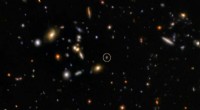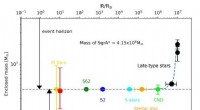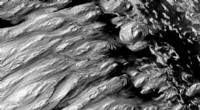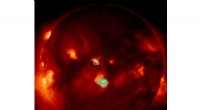
Wetenschap
Waarom wordt een bruine dwerg geen echte ster?
Hier is een uitsplitsing:
* kernfusie: Stars generate energy through nuclear fusion, where hydrogen atoms fuse together to form helium, releasing immense amounts of energy. This process requires immense pressure and heat, which are only achievable in the cores of massive objects like stars.
* Mass Threshold: There's a critical mass threshold for a star to form. This threshold is roughly 8% of the mass of our Sun. Objecten onder deze drempel, hoewel ze zich kunnen vormen uit dezelfde instortende wolk van gas en stof als sterren, missen de zwaartekrachtpull om de nodige druk en temperatuur te bereiken voor aanhoudende fusie.
* Brown Dwarf Fusion: While brown dwarfs don't achieve sustained fusion, they can undergo deuterium fusion for a short period. Deuterium is a heavier form of hydrogen, and it can fuse at lower temperatures and pressures than regular hydrogen. However, deuterium is relatively rare, and this fusion process eventually runs out, leaving the brown dwarf as a substellar object.
Samenvattend:
* Brown dwarfs are "failed stars" because they are below the mass threshold needed for sustained hydrogen fusion.
* They can undergo deuterium fusion briefly, but this is not a long-term energy source.
* Their lack of sustained fusion prevents them from shining brightly like true stars.
 Buffers berekenen
Buffers berekenen  Wat is tegenstraling?
Wat is tegenstraling?  Zoutoplossing produceert betere organische elektrochemische transistors
Zoutoplossing produceert betere organische elektrochemische transistors Snel reagerend, kleurveranderende moleculaire sonde detecteert wanneer een materiaal op het punt staat te falen
Snel reagerend, kleurveranderende moleculaire sonde detecteert wanneer een materiaal op het punt staat te falen Wat is de linkerkant van een chemische vergelijking die wordt genoemd als u ze in evenwicht brengt?
Wat is de linkerkant van een chemische vergelijking die wordt genoemd als u ze in evenwicht brengt?
 Mexico's weg naar herstel na aardbevingen is veel langer dan het lijkt
Mexico's weg naar herstel na aardbevingen is veel langer dan het lijkt Verzuring belemmert schelpontwikkeling van plankton voor de Amerikaanse westkust
Verzuring belemmert schelpontwikkeling van plankton voor de Amerikaanse westkust Onderzoek naar de risico's en realiteit van bosbranden
Onderzoek naar de risico's en realiteit van bosbranden Wat zit er in jouw wiet? Je zult misschien verrast zijn
Wat zit er in jouw wiet? Je zult misschien verrast zijn  Mensen vormen een steeds groter uitstervingsrisico voor dieren:beoordeling
Mensen vormen een steeds groter uitstervingsrisico voor dieren:beoordeling
Hoofdlijnen
- Wat is dit een eenvoudige suiker die energie kan leveren aan het organisme betekent?
- Bestaat er een verborgen geneesmiddel tegen kanker?
- Wat kunnen fossiele schelpdieren ons vertellen over onze ecologische toekomst? Veel.
- Wat doet eicel voor een plant?
- Onderzoekers ontdekken dat het koelen of aan de lucht drogen van bodemmonsters voor toekomstig onderzoek belangrijke microbiële details behoudt
- Onderzoekers ontdekken hoe cellen bewegen terwijl ze adhesie vermijden
- Hoe heeft Louis Pasteur zich verhouden tot de ontwikkeling van genetische?
- Elementen van nucleïnezuren
- Wat is de specifieke celontvanger bekend?
 Waarom is taxonomie belangrijk voor communicatie over biologie?
Waarom is taxonomie belangrijk voor communicatie over biologie?  Hoe werken oorthermometers?
Hoe werken oorthermometers?  Huishoudelijk werk bijna gelijk voor jongens en meisjes
Huishoudelijk werk bijna gelijk voor jongens en meisjes Waarom is Horus de god van de lucht?
Waarom is Horus de god van de lucht?  Wat heeft een elektrisch neutraal atoom gelijk aantal?
Wat heeft een elektrisch neutraal atoom gelijk aantal?  Boek maakt nanotech toegankelijk voor kleinere lezers
Boek maakt nanotech toegankelijk voor kleinere lezers Biomassabrandstoffen kunnen de opwarming van de aarde aanzienlijk verminderen
Biomassabrandstoffen kunnen de opwarming van de aarde aanzienlijk verminderen 10 misvattingen over GGO's
10 misvattingen over GGO's
- Elektronica
- Biologie
- Zonsverduistering
- Wiskunde
- French | Italian | Spanish | Portuguese | Swedish | German | Dutch | Danish | Norway |

-
Wetenschap © https://nl.scienceaq.com






